Drip Drip Déjà Vu
June 23, 2018
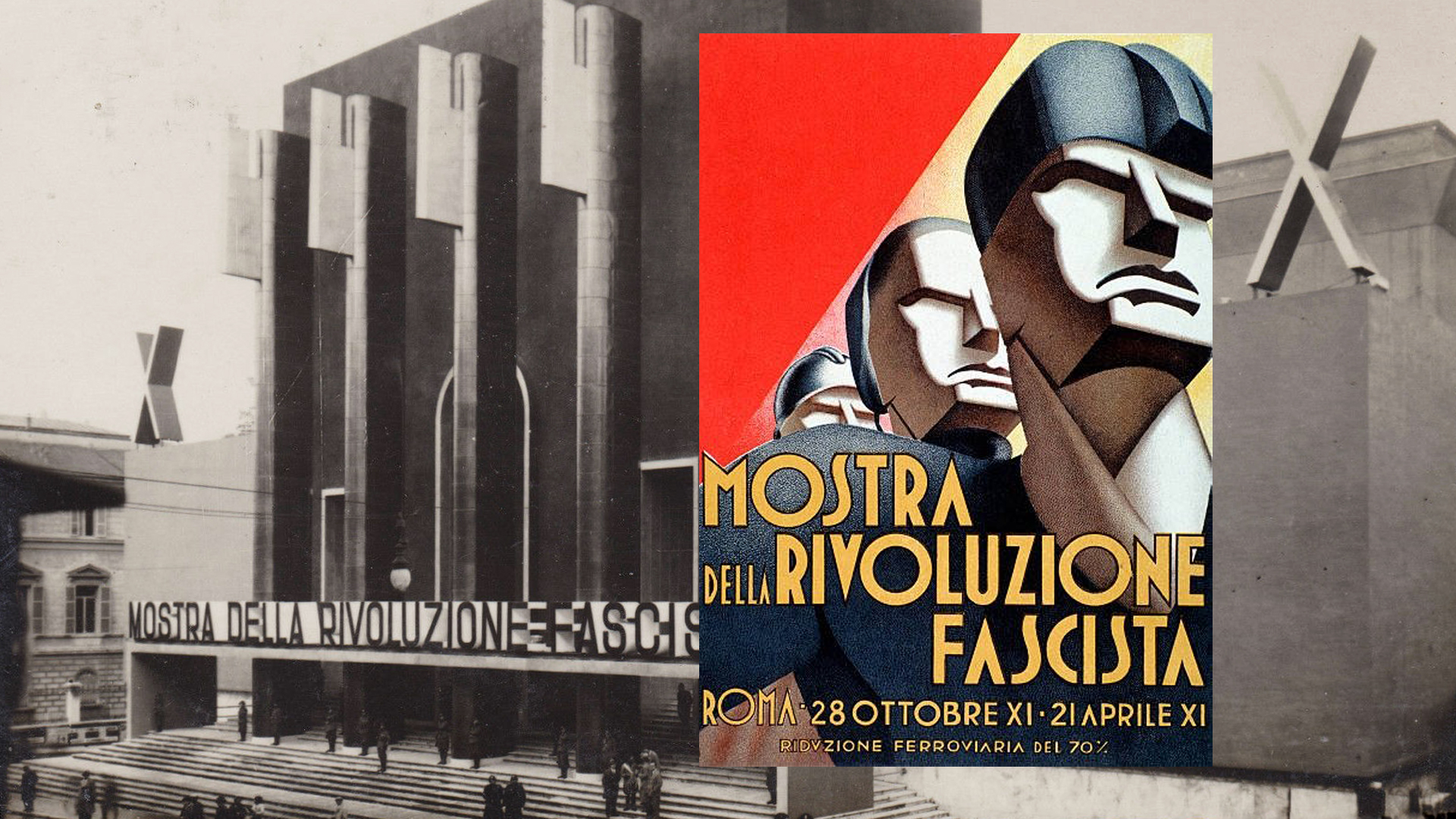
Artworks and images from the Mostra della Rivoluzione Fascista (Fascist Art Expo) were featured in the PRADA Foundation’s colossal exhibition. The Fascist Art Expo was held in Rome from 1932 to 1934. It had its own Futurist exhibition hall. It was opened by Benito Mussolini and had over four million visitors. Poster by Gino Boccasile.
It’s next time again.
Logistics when you travel can sometimes be confusing. When you are in a foreign country; so much the worse. All you can do is the best you can. You check your destination’s website (in Italy usually not updated). You double check the hours and if you are really paranoid you call ahead and confirm.
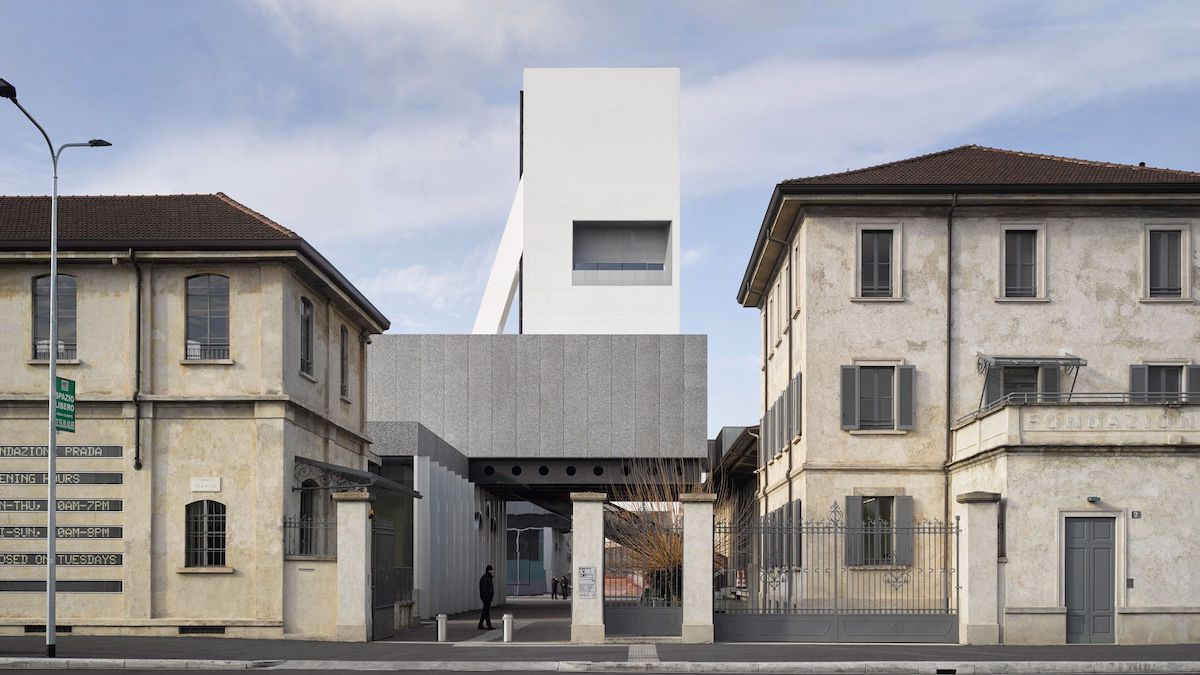
The Prada Foundation complex in Milan designed by Rem Koolhaus. NYT architecture critic Michael Kimmelman calls it a “Microcity of Secrets.” Note the new tower in the background. Photo courtesy OMA
Just imagine my frustration at recent events. I took an early morning train from Venice to Milan, waited in a taxi cue for 50 minutes (why oh why is Milan so busy?) and then another 30 minutes for a stop-and-go cab ride through unusually constipated traffic. Around noon, I finally get to the front gate of the Prada Foundation museum complex to see their spectacular (some say colossal) new exhibition on between-the-wars art in Italy. The front gate is ominously closed. When questioned, the rather swarthy guard behind the gate mutters, “Chiuso! Oggi e domani – chiuso!” He then just gives a defiant look instead of the typical Italian shrug. What?! They were closed all day and tomorrow? I must have read the hours wrong. I looked over at the sign. Nope, supposed to be open all day Thursday and Friday. Turns out our visit coincided with Design Week in Milan. The museum had decided to close to prepare for the dramatic opening reveal of “a zigzagging new tower” designed by Rem Koolhaas. They were setting up the ribbon cutting events for the International design crowd who had descended on the city for the most important design show of the year. Days later, the New York Times explained, “The nine-story tower (of the Prada Foundation) completes Koolhaas’s plans for the 200,000-square-foot site, the largest arts destination in the city, after three years of construction.” So it goes. (If you are interested in the architecture of the tower please see Michael Kimmelman’s outstanding review linked here: Kimmelman on Koolhaas)

Two views of the new gallery tower at the PRADA Foundation. Michael Kimmelman calls it, “a slim, milk-white concrete block, nine stories high, punctuated by loggias – a signpost, like the traditional village bell tower, rising above a low, scruffy neighborhood.” Photo courtesy OMA
Nothing to be done about it so an extended visit to Milan’s newly updated and masterpiece-filled Brera Museum became a good substitute. After returning to Venice, I was unsure about making a follow up trip to Milan for the Prada show. Then I came across a review by Riccardo Conti, who writes for DOMUS, the always cool and trendy Architecture magazine. He said,
“[This show] has the merit of not projecting an assertive hypothesis onto the myriad aspects it covers. Instead, it takes a new and heuristic look at the past, in the hope of encouraging deeper political judgements on the threat of similar phenomena in the present. Because of this it perhaps represents one of the most powerful and difficult exhibitions put on to date by the Prada Foundation, or more generally by any private international foundation.”
Great ideas combined with a fun new word. Heuristic. I’ve seen this before in Art History writing. What does that really mean? It is a fancy word for “figure it out for yourself.” It involves innovative problem solving. Another way to define it might be lateral thinking or the darling of corporate-speak, “thinking outside the box.” So the next time you are in one of those endless meetings and the group decides they want you to think outside the box just pause and say, “No problem, I adore heuristic reasoning and I’m terrific at it.”
In this context the word heuristic means Germano Celant has done what a truly great curator should do. He has put on a show with an astounding 500 works of art and arranged them in such a way as to encourage you to think for yourself about what they all mean. Be still my heart.
There was another word in Conti’s review that you might have missed – “difficult.” Yes it was. I read that Byron studied Armenian because he loved to “break his mind” on something really difficult. This exhibition accomplished this and then some. It was wonderfully unapologetic. It was filled with high quality art imaginatively displayed to provide maximum historic context. It refused to talk down. In a world Disneyfied by click-bait headlines, tabloid TV, and government by twitter, this exhibition was intellectually refreshing. It was a relentless, astounding death march of ideas and I loved every minute of it.

Considered to be the first machine-made art book, F.T. Marinetti’s avant-garde poetry book originally sold for 3 lire. Now, an original copy might cost you $3000.
The bizarre title of the show, Post Zang Tumb Tum. Art Life Politics: Italia 1918–1949 comes from an avant-garde “tone poem” written in 1912 by Filippo Tommaso Marinetti. The book was laid out with innovative typography and dizzying graphic design. The best way to read the title is with your lips pursed and with a bit of humming you can turn it into ominous sounding music. ZANG-TUMB TUMB-TUMB TUUUUUUM.
No poetry before us
with our wireless imagination
and words in freedom LOOOng live
Futurism finally finally finally finally finally finally finally
Poetry being BORN

Filippo Tommaso Marinetti who has been called “the original speed freak” artfully posed with articles about his 1909 Futurist Manifesto.
Filippo Tommaso Marinetti founded the Italian Futurist party and co-wrote the first Futurist manifesto in 1909. He later helped to write the Fascist Manifesto. Art, Futurism and Fascism merge in Marinetti’s vision for Italy’s future. He said, “A new beauty has been added to the splendor of the world – the beauty of speed. Time and Space died yesterday. We already live in the absolute, because we have created eternal, omnipresent speed.” Futurism advocated “a rejection of the past, and a celebration of speed, machinery, violence, youth and industry; it also advocated the modernization and cultural rejuvenation of Italy.” Futurism might be looked at as as Cubism put into motion through the turbo-boost in speed made possible by machines.
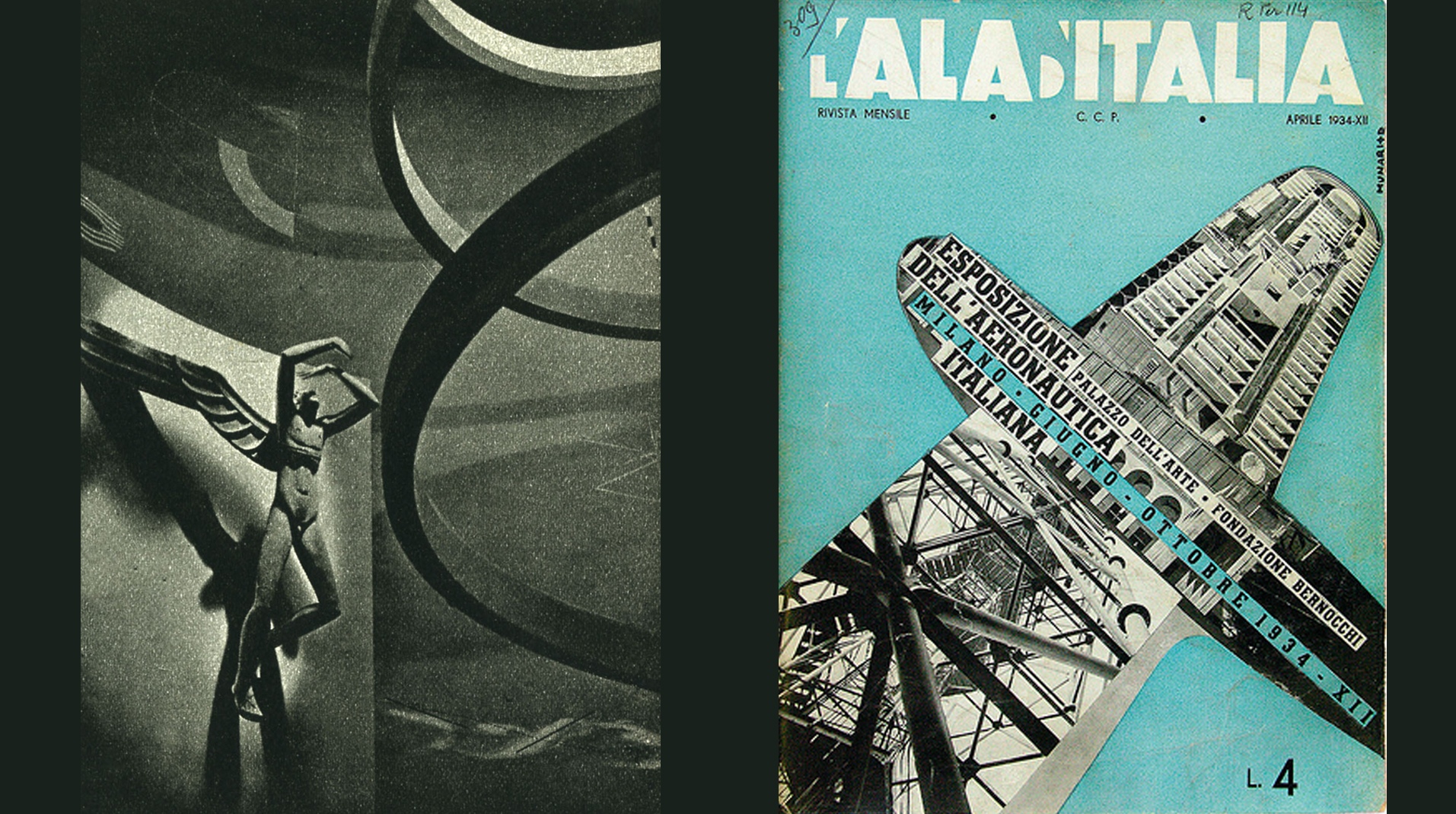
Images from the government sponsored Aviation show held in Italy in 1934. Nothing symbolized speed and the future like airplanes. A suspended sculpture of Icarus by architect Giuseppe Pagano greeted visitors in the spiraling sky-lit main hall.
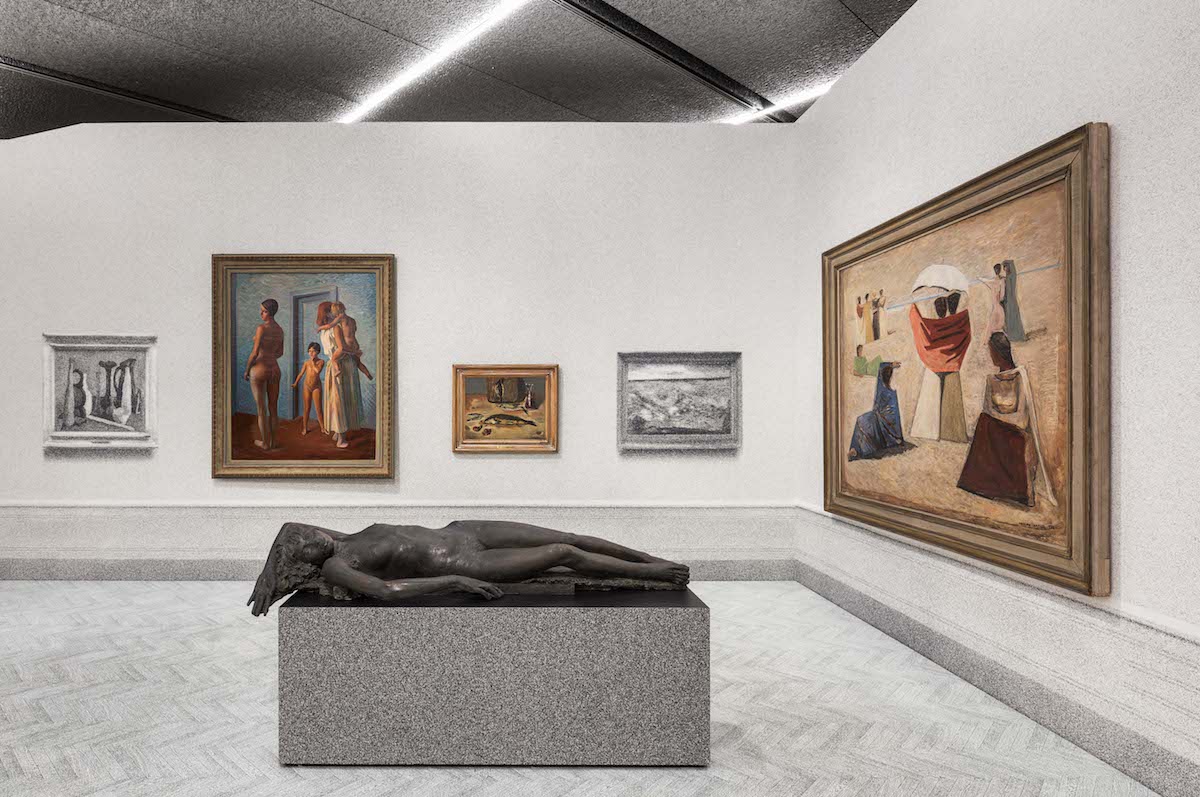
One of the representative galleries in the exhibition. Note the real paintings by Mario Tozzi (left) and Filippo de Pisis (right) and Massimo Campigli (far right) set into the life-sized documentary photo mural which shows a black and white image of how the paintings were originally displayed. The sculpture in the foreground is by Bruno Innocenti. Photo Delfino Sisto Legnani and Marco Cappelletti Courtesy Fondazione Prada
One key concept of the exhibition’s imaginative display was the idea of “in situ.” It is always a treat when you can see an artwork in the original location for which it was made or, in this case, first displayed. To accomplish this for the exhibition the curators sometimes blew up documentary photographs of historic exhibitions until they became soft, fuzzy and one-to-one scale (meaning life size). For example, you would see a monochrome photo mural wall of five historic paintings but the third one from the left is the real painting hung in situ just the way it was in an historic exhibition. When this wasn’t possible there was still the ghost of exhibitions past evoked with small documentary photographs showing Mussolini at an art opening looking at the same painting you are about to see. Or, in a small photo you would see an artist in his studio leaning over the back of bronze sculpted horse. In this case, to see the photograph, you had to sort of lean over the actual bronze-sculpted horse. You get the idea.
There was a method to all this in situ effort. Carefully curated historical facts and a documentary sense of authenticity were a featured focus of the show.
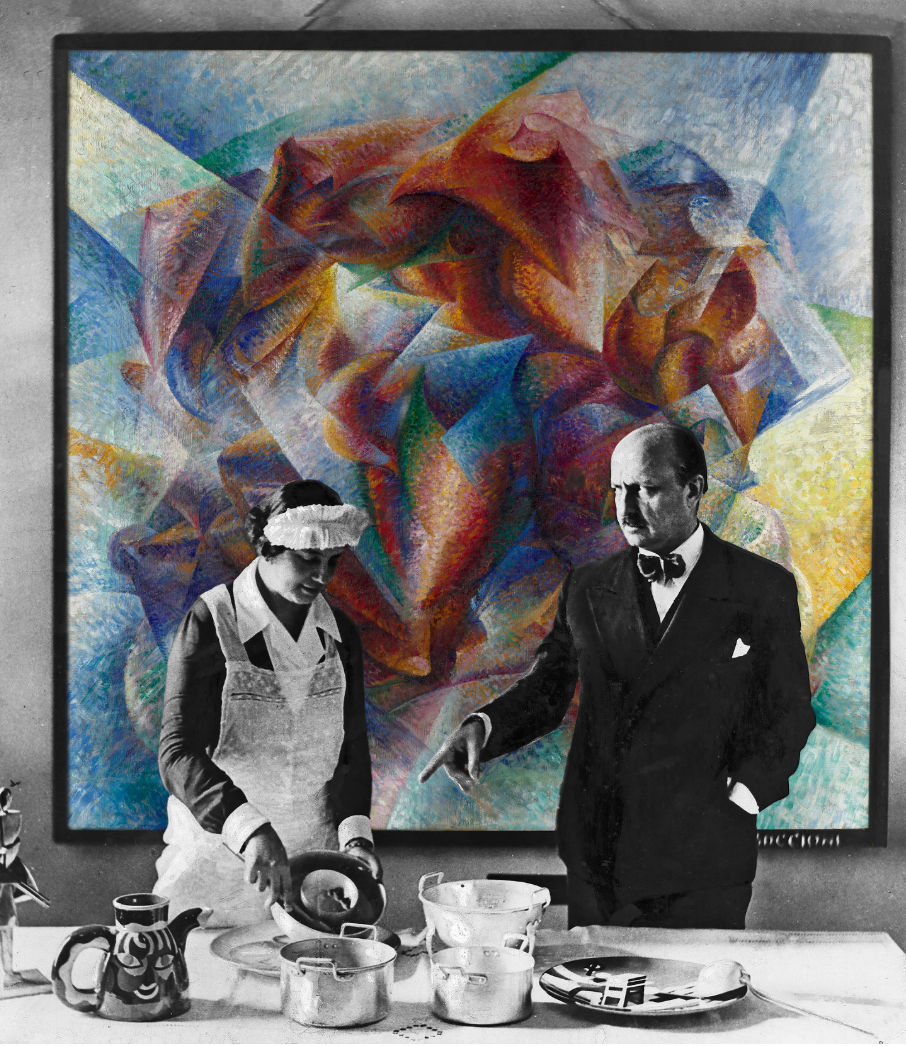
Surrealist Dada-like portrait of Filippo Tommaso Marinetti in his home (from Wiener Illustrierte Zeitung and Berliner Illustrierte Zeitung, 1934). Ullstein Bild / Archivi Alinari © 2017. Digital image, The Museum of Modern Art, New York / Scala, Florence. In the background: Umberto Boccioni, Dinamismo di un footballer, 1913. Museum of Modern Art (MoMA), New York © 2017. Digital image, The Museum of Modern Art, New York / Scala, Florence.
Above is perhaps the seminal image of the entire show. Hard to figure this one out but the clues are there in plain sight. See now Filippo Tommaso Marinetti in a black and white 1936 Dada-like photographic portrait. In the original photo the painting behind him was in black and white. The color painting was digitally inserted with photoshop. The painting is a very cool Futurismo masterwork by Boccioni. In the show, you see not only the full size painting loaned from the Museum of Modern Art but also a ceramic pitcher very much like the one on the counter at the far left. The descriptor informs you, Mr. Marinetti is the “father of Futurismo.” His biography parallels the entire premise of the show because at first he embraces the bold future promised by Fascism but ultimately rejects it because of its brutality. By the end of the this exhibition you feel as though you have vicariously lived his life and have come to the exact same inevitable conclusion.
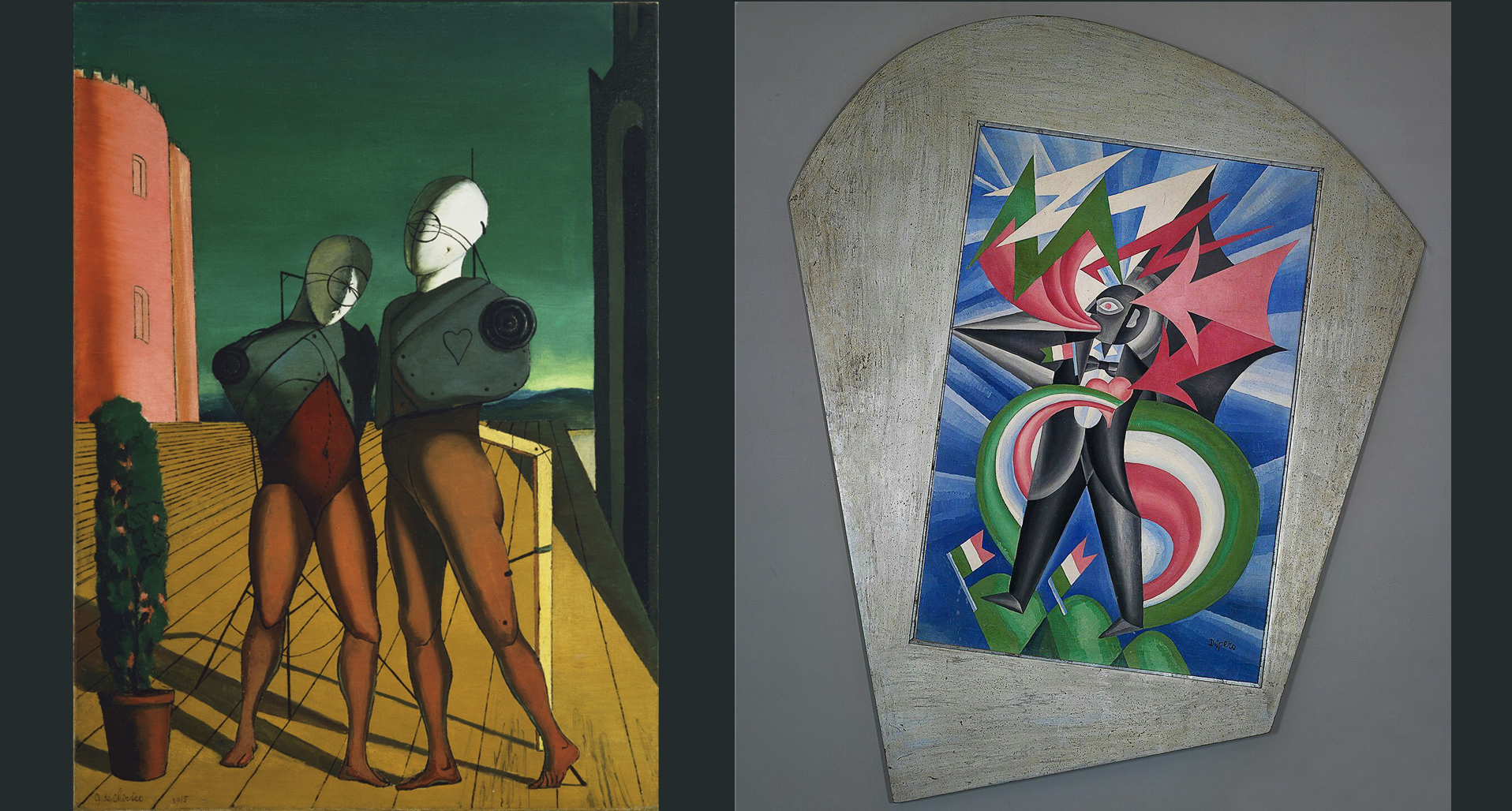
Giorgio de Chirico was a featured artist in the exhibition and appeared many times. “The Duo” was loaned by The Museum of Modern Art © 2018 Artists Rights Society (ARS), New York / SIAE, Rome. The Duo’s Surrealist feel melded seamlessly with Futurismo themes. Fortunato Depero’s “Marinetti temporale patriottico” (right) from 1924 appeared as one of the first paintings in the show. This dynamic portrait of F.T. Marinetti (the father of Futurism) in a rhetorical thundercloud of Italy’s Red White and Green colors was emblematic of the entire experience.
This is a mammoth show which covers the years from 1918 to 1943. Almost each year gets its own room! In each of the 24 galleries (to unfairly narrow things down to the comprehensible) I searched for four major themes; History. Life. Art. War. There was, of course, much more going on but these themes were the ones I grabbed onto as conceptual handrails to try to keep my intellectual bearings.

Chair and coffee table grouping by architects Luigi Figini and Gino Pollini, 1935. Photo Delfino Siston Legnani and Marco Cappelletti, courtesy Fondazione Prada
I love well-designed furniture and was comforted by the artistic groupings of wonderful originals by great architect/designers like Piero Bottoni or Luigi Figini and Gino Pollini (who did lots of work for the famous design-oriented typewriter company Olivetti). These tactile, sometimes homey, assemblages gave your eye a place to rest. You could imagine sitting in those chairs and perhaps you would be gazing at the art on the walls in front of you. Or, you might be reading one of the books or magazines or newspapers contained in the nearby glass cases.

Furniture by Futurist architects provided lifestyle clues to the period. On the left is the Olivetti headquarters designed in 1939 by architects Luigi Figini and Gino Pollini. On the right is one of their exquisitely designed tubular chrome chairs designed in 1935.
The furniture implied a lifestyle. The photos in the archival newspapers often contained the same art you were seeing on the walls. The timelines, articles and books chronicled an unnerving chaos of ideas. Through it all, you were forced to think about the history and the drip drip drip of ugly events leading inexorably to world war. The drip drip drip also gave you a very unsettling feeling of déjà vu. Because this show looks backwards to the past you already know how this ends but, in so many ways, these drips feel eerily connected to the here and now. As I walked through the show I often felt like brushing a phantom spider of present day insight off my arm.

Benito Mussolini and Adolf Hitler in Munich, Germany, ca. June 1940. Like-minded authoritarians who seemed to enjoy each others company. Eva Braun Collection. (Foreign Records Seized)
As you entered each gallery, many of which were wallpapered with utilitarian brown burlap, you got a small, dense month-by-month timeline of ominous historic facts. These facts drenched the art in each room with compelling irony. Innocent family groupings became oddly complicit. Otherwise tame bronze animals or open-mouthed giant heads came screaming to life from impending nightmares. For example, did you know Mussolini declared an official wedding ring day in 1939? The idea was you showed up and donated your wedding ring to finance his war in Ethiopia. Who would think of such a thing? Or how about Mussolini’s institution, in 1927, of the Bachelor Tax, a “race-based pro-natalist policy.” Then there comes the death of Lenin and Stalin’s rise to power or the first meeting of the “black shirts” or the start of certain anti-fascist magazines or the exile or arrest of this or that artist like Venturi or Carlo Levi. All these individual moments intertwine with the artworks. It’s like a moody and foreboding film montage where the individual shots add up to much more than the component parts.
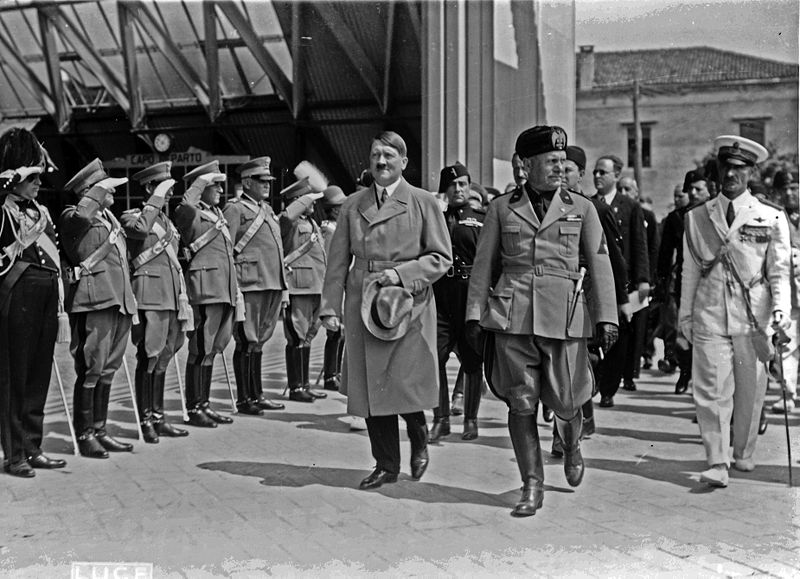
The first meeting of Adolf Hitler and Benito Mussolini was in Venice in 1934. They attended the Venice Biennale where they exchanged Fascist salutes on the steps of the German Pavilion.
As I read each room’s timeline I was buoyed by the regular-as-clockwork two year drumbeat (or was it a heartbeat) of the Venice Biennale of Art. It started in 1895 and has run almost consistently every two years since. I, of course, love the Biennale and have profound respect for its tenacity but I had never before looked at its vaunted history in quite this manner. Celant used the Biennale the way an archeologist uses core samples. It was uncanny. You, without him explaining a damn thing, started to see the art in the history and the history in the art.
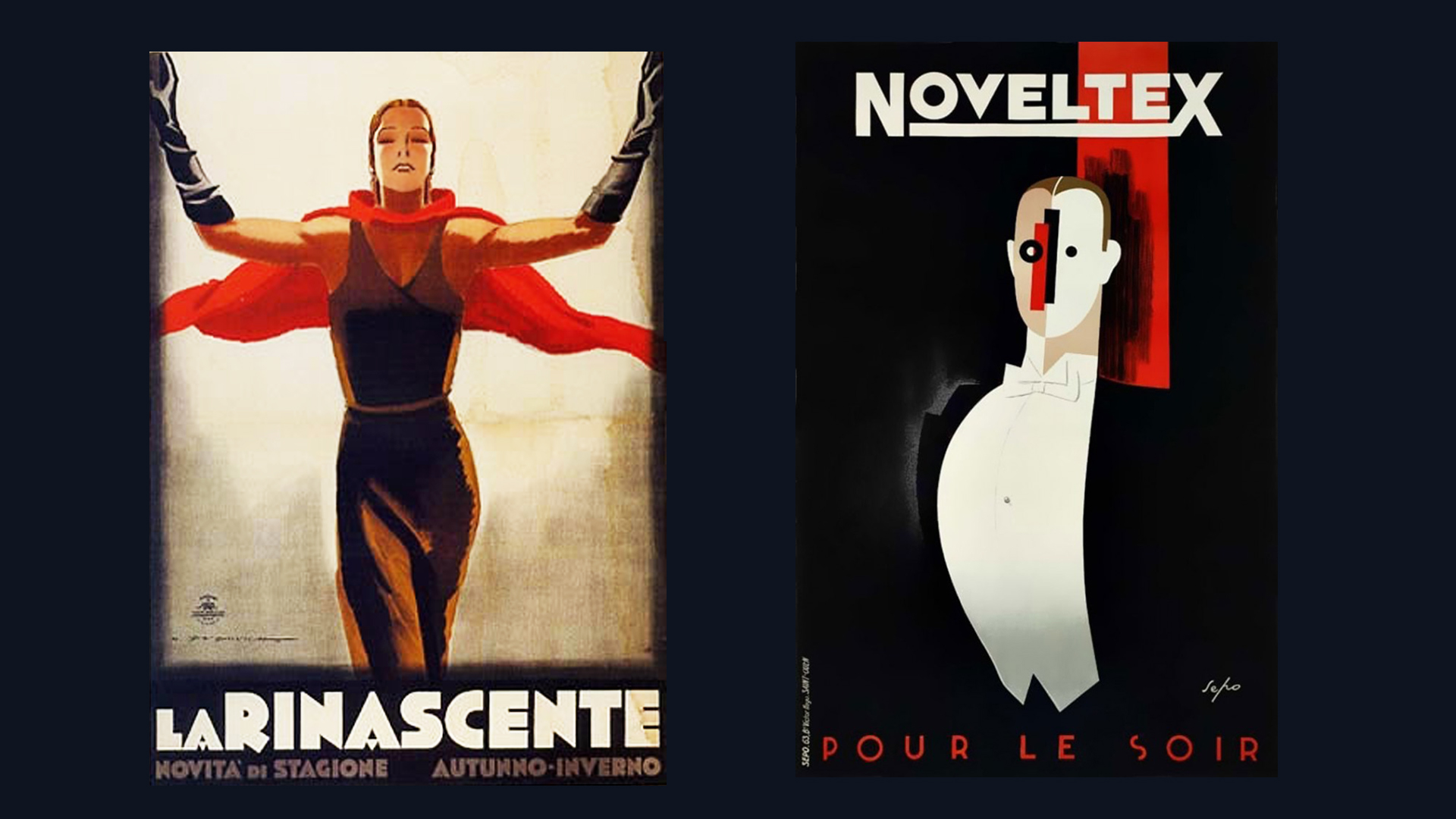
Italian Futurist graphic design retains its ravishing impact. The incomparable Marcello Dudovich created this poster for La Rinascente (a Milan Department Store) in 1928. The circa 1930 poster for Men’s Wear company Noveltex was created by the art deco master Severo Pozzati known as Sepo
Behind it all is Celant’s team’s marvelous artistic taste. They cherry-picked the best available and most significant from every medium you can imagine. Here were newspapers, photographs, artist’s sketches, architectural drawings and models, posters, bronzes, oil paintings, furniture, magazines, plaster casts, giant heads, building concepts, the list goes on and on. In less capable hands this would become a tired garage sale but instead, you somehow knew every object was carefully chosen. Nothing felt accidental. Every object had quality and meaning. The question was, would you have the strength to discover it?
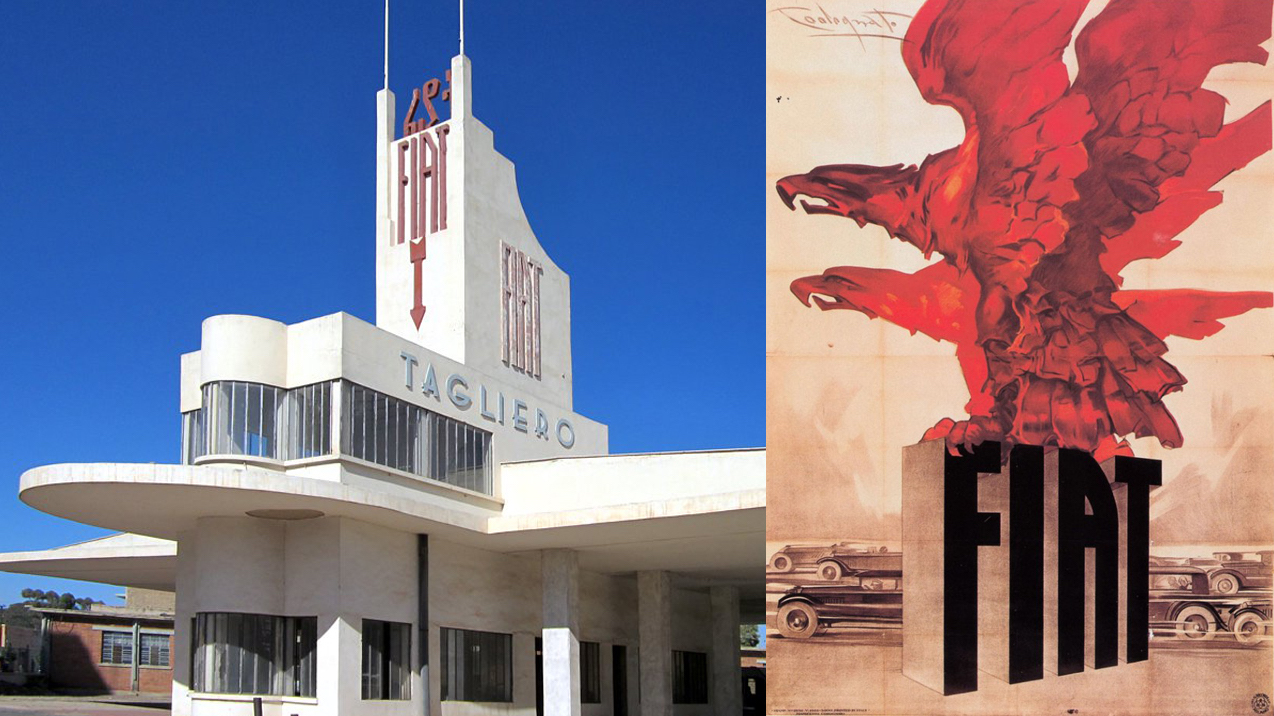
This Futurismo airplane-inspired gas station was designed by Giovanni Tagliero. It was built in 1938 in Asmara, which is the capital of the Italian province Eritrea in Africa. Mussolini “unified” these provinces in the mid-1930s including conquest of Abyssinia and Ethiopia. The Fiat poster was created by Plino Codognato in 1923.
For example, the Italian auto maker Fiat was featured in the early timelines. The exhibition included not only images of their cars and advertising but also fabulous futuristic designs for Fiat showrooms and service stations. Then, inserted in the last timeline, a haunting 1943 photograph of the bombed out Fiat factory complex in Turin. It was a gut punch.
The last room of the exhibition contained two enormous tables. The one on the left was archival quality books and periodicals under glass but the one on the right made you feel you had just entered the Futurismo Bookshop. Neatly piled on this huge table were about 500 fabulous art books, exhibition catalogs and monographs on the people events and art that you had just seen in the exhibition. The books looked new but cried out for your attention. I asked the guard if it was OK to touch them and she nodded with a smile. It was a candy store of ideas. I eagerly leafed through books on Pollini’s furniture and books on Futurismo Cinema. You could have browsed all day. This was quite literally the exhibition bibliography in situ. It was hugely impressive. What a stroke of genius to put all their research so effectively on display for you to marvel at and enjoy.
Current events make it impossible to forget the multiple meanings of this magnificent exhibition. To have witnessed the ideals of Futurism incrementally usurped and re-purposed by Fascism makes reading and watching today’s news a powerful déjà vu. In researching this review I came across a terrifying comment by the highly-respected foreign correspondent, Dorothy Thompson. She was no stranger to trenchant analysis. In fact, she was married to the first American Nobel prize winner, Sinclair Lewis whose works are renowned for their “insightful and critical views of American capitalism and materialism between the wars.”
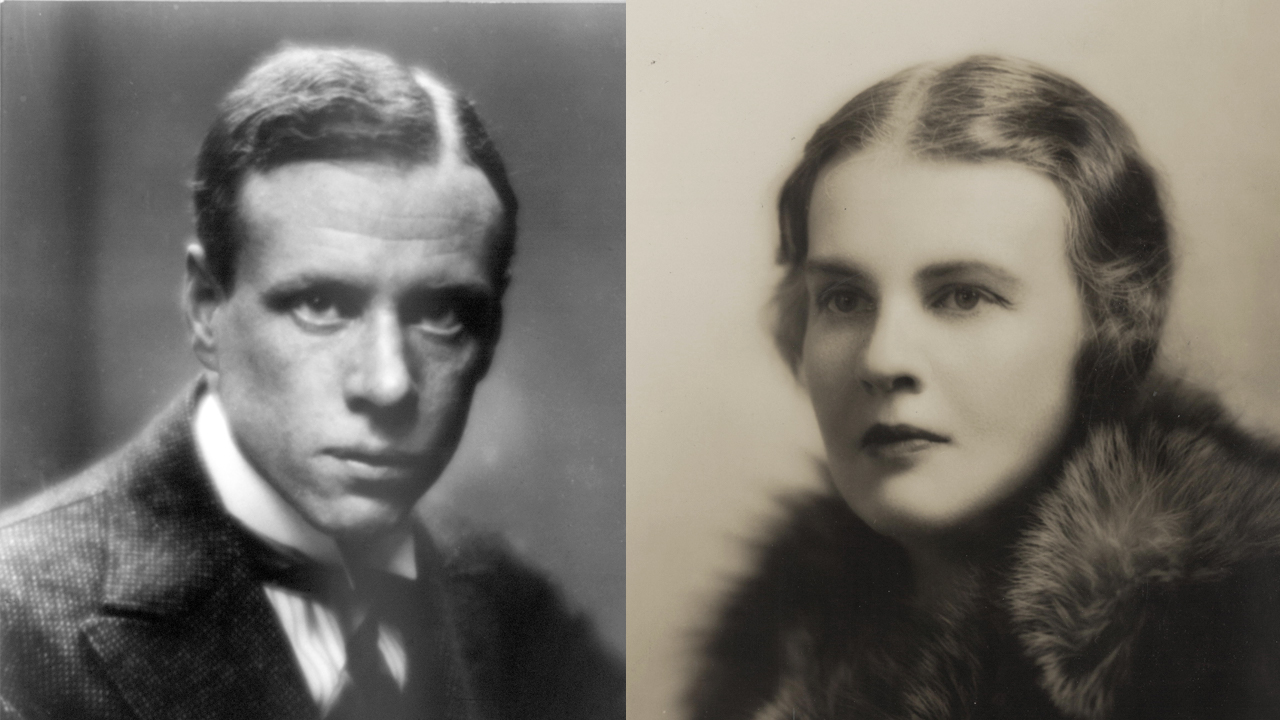
Sinclair Lewis was the first American to win the Nobel Prize for Literature (1930). His wife, Dorthy Thompson was a well known Journalist and Broadcaster. She was a prominent member National Woman’s Party [NWP]. She lectured on feminism for the benefit of the Equal Rights Amendment Fund.
In 1928, after meeting Hitler, Dorthy Thompson described him as a man of “startling insignificance.” Did that give you any creepy drip of déjà vu? In 1935, she was highly self-critical of her delusion. She said,
“No people ever recognize their dictator in advance. He never stands for election on the platform of dictatorship. He always represents himself as the instrument of Incorporated National Will. …When our dictator turns up, you can depend on it that he will be one of the boys, and he will stand for everything traditionally American. And nobody will ever say ‘Heil’ to him, nor will they call him ‘Führer’ or ‘Duce’ [Mussolini’s title]. But they will greet him with one big universal, democratic, sheeplike bleat of ‘Okay, Chief!’”
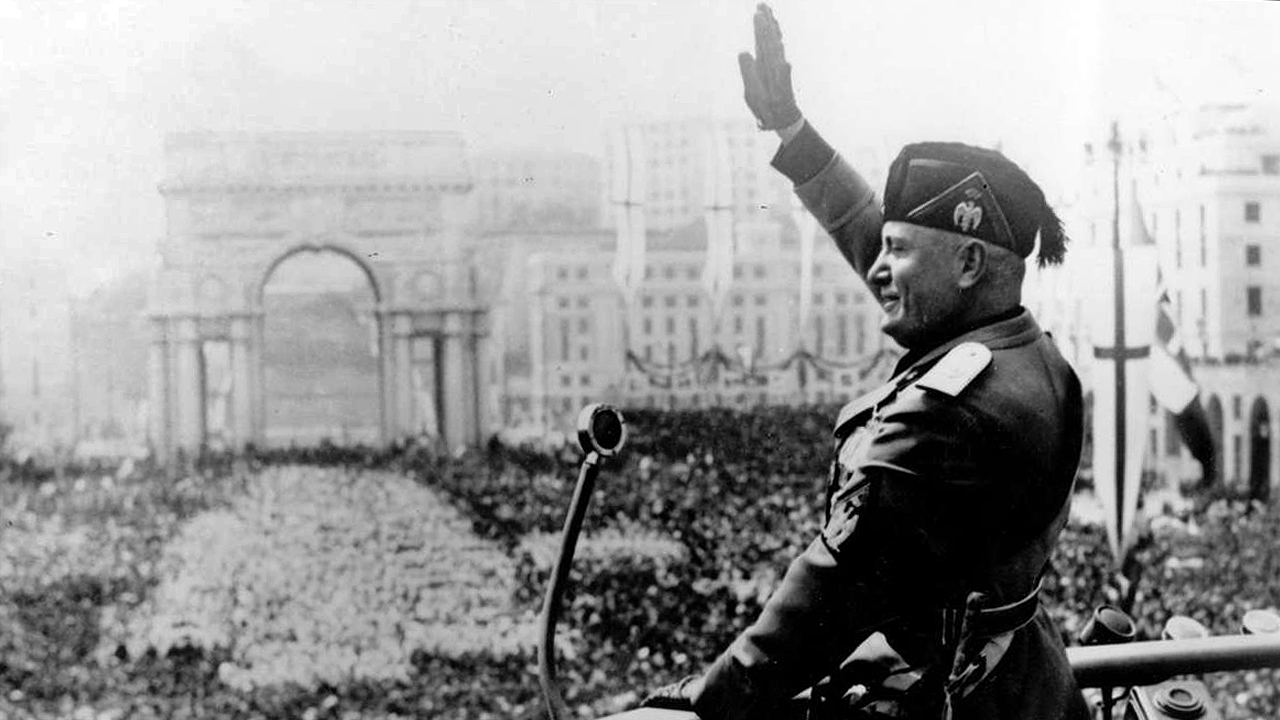
Benito Mussolini enjoys the roar of the crowd at a 1938 rally in Rome.
In the dizzying speed of present day political events, historic meanings get blurred. What is just meaningless noise and what is actually significant? The campaign strategist, Steve Schmidt, in a moment of decisive clarity put it this way, “Make no mistake about it when you’re ripping breastfeeding children away from their mothers and putting them in detention facilities. That’s an evil policy.” In protest, he recently quit the Republican Party.
The Daily Beast reports, “In the absence of constitutional checks, Schmidt says Americans reluctantly must cast their eyes toward Europe in the 1930s.”
“What are the hallmarks here? He uses mass rallies to incite fervor and followers who are now more like cult members than voters. Every problem has an easy group to blame—minorities, chiefly—he creates a sense of mass victimization, he alleges conspiracy by unseen forces, and he asserts that only he can stop it and protect the victims—and stop the villains, the minorities. The last step of this is an assertion: ‘I’ll just need more powers to do it.’ And that’s how a constitutional republic dies.”
Until next time, with much love, I remain your,
Tommaso





7 Comments
Tom,
As always an mind-opening education in art and humanity. I look forward to your next publishing! And next time I will not let it get buried under a mountain of emails.
Wonderful post once again dear Tommaso! The minute I started reading your blog, I smiled remembering my first trip to Florence. My cousin and I were traveling together and we had only three days to visit Florence…We saved the last day to visit a famous church…well, supposedly it was open, but there was some religious festivity and it was closed. My favorite Italian story related to that trip was in Rome, where we purchased a package to visit some cultural sights. It ended at the Coliseum. Once the bus arrived there full of excited tourists, it was closed. The tour guide soon after borrowed a book that someone was selling there, and started to show us the Coliseum turning the pages on the book! Well, the future, regardless of the vision they had in the show, will never change those wonderful Italians…Seeing the great selection of images you captured, I long for another trip to beautiful Italy, and especially that show. So many aesthetic qualities were alike around the time…films like Metropolis,the portraits of Tamara de Lempicka..the gorgeous type they used in the posters. Thank you so much for sharing this with all of us!
This just in. Clive Irving looks at Trump in “early stage” Mussolini:
https://www.thedailybeast.com/it-is-happening-here-trump-is-already-early-stage-mussolini?ref=home
Ciao Tom,
Thoroughly enjoyed your blog, but then I always do! It is a troubling time politically not just on this side of the pond but in Italy too. Being a native Italian I am feeling uneasy about the recent elections, the language of the new government smacks of yesteryear populism, it is all very disturbing indeed. The exhibition for which you make a compelling case applauding the curatorial expression clearly is well timed, and I thank you. Hopefully I too shall have the pleasure of seeing it before it closes. Grazie mille Tom!
Tom
So glad you got to see this exhibition. It is one of my favorite periods of European art and architecture. Powerful work being created during a time of turmoil.
Last year we saw a great show at the Art Institute of Chicago that focused on Soviet propaganda art from much of the same period. Their graphics were amazing. And, how about those Germans?
Thanks for sharing.
Dennis
Dear Tommaso,
This is a very compelling invitation to a show I would have missed, for the very drip-drip, scary deja-vu you mention. And I am glad you can see the art in the history and history in the art. I do like the FIat sign with those red and fluffy eagles. (Are they griffons?) And most of the rest I don’t like; and would just get more tense, walking through. One of the things I thought about was the person who joined the idea of “speed” with fascism and the future. This is a time when our society’s frenetic pace feels sometimes like the whole society is taking amphetamines, and is frazzled and brittle. So that was definitely a zinger to the heart of NOW. And the rise in fascism all around is pretty darned scary, and maybe it is all related to caffeine over-drive and amphetamines in the people. The loss of personal details, the loss of small pretty accents, corrective individual querks, and presentation of “a man of the masses” who looks like what we think of now as a robot, is another insightful visual tip. I loved most that pile of books at the end, where you can see the research and browse through the individual artists words and thoughts. I want to renounce the underpinning of the show, and get back to the lovely and the classical. Thanks for this provocative lesson! With love, martina
Dear Tom,
I also have to say something about the word “Heuristic”. It warms the cockles of my heart, as it is a very important word in philosophy. You probably remember that I majored in philosophy! I was taught in metaphysics, that the stuff of knowledge fits into heuristic structures of thought, much as we fit things into boxes for mailing, or for packaging something. A heuristic structure in philosophy is something like a steel girder skeleton of a skyscraper– you are going to fill it with the rest of the building, with the details and the actual stuff, but you need this scaffold to begin with. The scaffold in thinking is the outline or the container of such information, and how it fits together with other information. For example, we could say that knowledge is sort of like a castle, with lots of turrets and rooms, and occasionally a whole wing gets redone, when it seems it is too narrow or too dark, or a whole new idea comes about. (for example, when physics was grappling with what Einstein said, which shifted us away from Newtonian physics. We acknowledge that we started with Newtonian physics, but we have this second or third floor, where a more sophisticated model exists, and where finer tuning for what is real can be done by scientists working at the edges of knowledge in this field. We have to use the materials we know, and we have to build on what has come before. Kant worked to try to explain categories of thought such as gravity, weight, space and time, sequence, coherence; ways we can describe scientific processes so that something can be checked for accuracy, or taught to someone else. How can we agree on what the scaffolding IS, for thinking and for exploring new theories or new data, finding new answers to our endless questions and with our ever-present curiosity? This is the issue of heuristics. Lonergan said that we are constantly expanding knowledge at the border of the known, with heuristic structures which are needing to be filled in. This also has to do with process, with evolution, with finding the boundaries of the known and then exploring something experimental beyond that. Thanks for sharing that word, which has so much philosophical nuance attached to it!